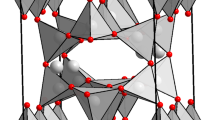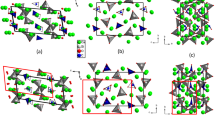Abstract
Phase transitions in minerals and melts that involve a change in the coordination of silicon from fourfold to sixfold are generally accompanied by large changes in material properties such as density, bulk modulus and elastic moduli. When such transformations occur within the Earth, these large changes in material properties can result in seismic discontinuities. The presence of six-coordinated silicon in minerals such as majorite garnet at upper-mantle pressures is therefore of crucial importance to an understanding of the properties of this region of the Earth. The silicate pyroxenes are also believed to comprise a significant portion of the upper mantle1, and to provide a host for large cations such as sodium and calcium. It has long been assumed that silicon is restricted to the tetrahedral sites within the pyroxene structure. Here, however, we report the high-pressure synthesis and characterization of single crystals of a pyroxene of nominal stoichiometry Na(Mg0.5Si0.5)Si2O6, which is the first pyroxene known to contain both tetrahedrally and octahedrally coordinated silicon.
This is a preview of subscription content, access via your institution
Access options
Subscribe to this journal
Receive 51 print issues and online access
$199.00 per year
only $3.90 per issue
Buy this article
- Purchase on Springer Link
- Instant access to full article PDF
Prices may be subject to local taxes which are calculated during checkout
Similar content being viewed by others
References
Takahashi, E. & Ito, E. in High-Pressure Research in Mineral Physics (eds Manghnani, M. H. & Syono, Y.) (American Geophysical Union, Washington DC, 1987).
Gasparik, T. Eos 69, 500 (1988).
Prewitt, C. T. & Burnham, C. W. Am. Miner. 51, 956–975 (1966).
Finger, L. W. & Prince, E. Natn. Bur. Stand. Tech. Note 854 (1974).
Curtis, L. et al. Can. Mineralogist 13, 62–67 (1975).
International Tables for X-ray Crystallography Vol. 4 (Kynoch, Birmingham, 1974).
Smyth, J. R. & Bish, D. L. Crystal Structures and Cation Sites of the Rock-Forming Minerals (Allen and Unwin, Boston, 1988).
Sinclair, W. & Ringwood, E. A. Nature 272, 714 (1978).
Swanson, D. K. & Prewitt, C. T. Am. Miner. 68, 581–585 (1983).
Horiuchi, H., Hirano, M., Ito, E. & Matsui, Y. Am. Miner. 67, 788–793 (1982).
Horiuchi, H., Ito, E. & Weidner, D. J. Am. Miner. 72, 357–360 (1987).
Gasparik, T. Geochim. cosmochim. Acta 48, 2537–2545 (1984).
Robinson, K., Gibbs, G. V. & Ribbe, P. H. Science 172, 567–570 (1971).
Fisher, R. X. J. appl. Crystallogr. 18, 258–262 (1984).
Author information
Authors and Affiliations
Rights and permissions
About this article
Cite this article
Angel, R., Gasparik, T., Ross, N. et al. A silica-rich sodium pyroxene phase with six-coordinated silicon. Nature 335, 156–158 (1988). https://doi.org/10.1038/335156a0
Received:
Accepted:
Issue Date:
DOI: https://doi.org/10.1038/335156a0
Comments
By submitting a comment you agree to abide by our Terms and Community Guidelines. If you find something abusive or that does not comply with our terms or guidelines please flag it as inappropriate.



